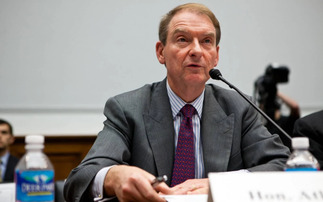With the dollar at a five-year high against a basket of currencies, and further strength against sterling predicted, Investment Week asks wealth managers which funds they are using to play the trend.
The dollar has rallied 8% against sterling since this summer, with the pound now worth $1.57, down from a high of $1.71. Many suggest this trend is set to continue now the US is viewed as more likely to hike rates first.
While UK investors keep their eyes on sterling, the dollar has also strengthened against other key global currencies, such as the yen and the euro, to hit a fresh five-year high against a basket of currencies yesterday.
With more monetary easing expected in Japan and the eurozone, and an election approaching in the UK, this trend shows no signs of abating.
US equity funds may be an obvious way to capitalise on this trend, Investment Week asked six fund selectors for alternative ways in.
AXA Framlington Global Technology fund
The £230m fund has performed well this year, returning 24.3% over the year to 3 December 2014, compared to a sector average of 16.7%, according to FE. The fund is 84% invested in North America.
“We like the underlying companies themselves, but we are also getting an added benefit,” said Wilson King, founding partner Craig Ray. “We are very happy to get this benefit for the first time in a long time.”
Scottish Mortgage Investment Trust
Managed by James Anderson and Tom Slater, more than a third of the £3.5bn trust is invested in North America, while the percentage of dollar assets is even higher. The trust grew its net asset value by 22% in the year to 10 November, compared to a sector average of 8.6%, according to FE.
“It buys large-cap growth stocks,” said Tacit Investment Management founder Raj Basra. “It has done extremely well. It is unusual because it does not fit into a normal wealth manager’s allocation strategy.”
Aberdeen Japan Investment Trust
“This fund has been helped firstly by the stock picking of growth companies but secondly by hedging their yen exposure,” Everys investment manager Tom Leahy said. “The companies got whacked but the fund only got half-whacked.
“The effect of the yen's fall against the dollar gives Japan a competitive opportunity. If you look at the S&P 500 it is not ridiculously expensive but it is quite costly.”
The trust grew its net asset value by 17.3% over the year to 10 November 2014, compared to a sector average of 6.5%, according to FE.
FP WHEB Sustainability fund
Despite underperforming over three years, the £78m ethical fund has enjoyed a turnaround in performance this year, with returns of 11.2% to 3 December 2014, compared to a sector average of 8.6%, according to FE.
“Because of the nature of the stocks the managers invest in, a lot of it is clean technology,” said Virtuo Wealth managing director Scott Murray. “That area tends to be based in the US or continental Europe, but the fund has increased exposure in North America over time.”
PIMCO Income fund
The US-based fund has bucked a difficult year for strategic bond managers, returning 8% over the year to 3 December 2014 compared to a sector average of -1.6%, according to FE.
“It is more skewed towards US assets like mortgage-backed securities than strategic bond funds run from the UK,” said Henderson multi-asset manager James de Bunsen.
M&G Global Macro Bond fund
Managed by Jim Leaviss, the £1.2bn fund has close to 85% of portfolio exposure in dollar denominated assets and has shown a strong correlation to the dollar over the last twelve months. "Leaviss proved to be a little early in his call and endured a difficult 2013 and first half of 2014 until the dollar finally turned in July of this year," Fiducia investment manager Tim Stubbs said.
"We have held the fund in our Cautious portfolio for over six years, and our investment committee has debated that decision several times during 2014 in particular. We made a decision to keep faith with the fund." The fund has returned 5.4% over the year to 4 December 2014, compared to a sector average of 3.3%, according to FE.
No fund at all
“We looked at a variety of [bond] funds, but concluded our clients would be better off investing directly in a short-dated US Government treasury bond,” said Cornelian chief investment officer Hector Kilpatrick.
“The reason being the funds we looked at had to take either interest rate or credit risk to generate a higher yield, from which we had to pay the fund manager’s fee.”













